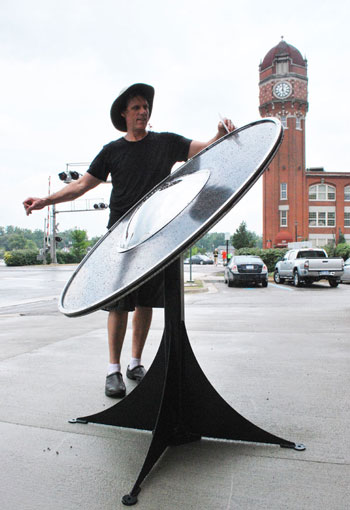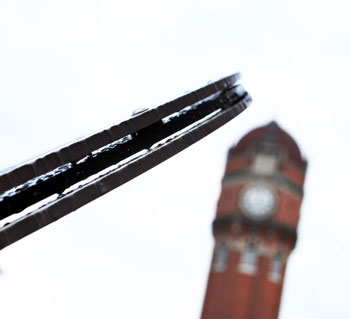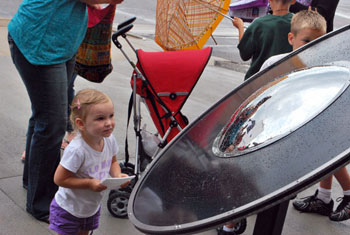Milestone: What The Chronicle Sounds Like
Here at The Ann Arbor Chronicle, we traffic almost exclusively in the written word. One clear exception is made for center-column articles, where we do try to include some photographs. Still, it’s rare that we take advantage of the full multimedia capability of the Internet.

Michael Flynn with his “cooperative phonograph” on Main Street in Chelsea, Michigan for the Sounds and Sights Festival on July 27, 2013. (Photographs by the writer.)
However, in the last couple of weeks, we’ve published two pieces that have included supplementary audio files. One was a write-up of a Ward 3 Ann Arbor city council candidate forum. The audio in that case served the purpose of grounding possible conversation about a she-said-he-said accusation in the actual facts of what-he-said.
The second one was a piece by regular columnist David Erik Nelson – about interviewing Noam Chomsky in the bar of the Campus Inn. The audio in that case served in part to provide a literal sense of what Chomsky “sounds like.” Just as a side note, I would argue that Nelson’s written treatment of the interview actually offers higher fidelity than the audio.
Today’s monthly milestone column also includes some audio. It was recorded from a roughly four-foot diameter “cooperative phonograph” fabricated out of stainless steel by local Ann Arbor inventor/artist Michael Flynn. Flynn had the phonograph on display last Saturday at Chelsea’s Sounds and Sights Festival.
Flynn was set up on Chelsea’s Main Street, just south of the iconic clock tower. He invited passers-by to use cards as “needles” to pick up the sounds from the ridges that he has cut into the edges of the metal disk.
I enjoyed watching as skeptical expressions from parents and kids dissolved into delight – as they discovered how the cards they were holding against the spinning platter were somehow generating music and words.
But an expression of delight won’t pay Flynn’s bills. The work of art took him over four years to develop – and he took on debt to make it possible. So Flynn is looking to sell the phonograph and to make more of them for sale – as a piece of public art or an interactive museum exhibit. That is how Flynn earns his livelihood.
As I watched kids and parents take their turns holding their cards against the edge of the rotating disk, the resulting sounds varied – depending on the size of the card, how tightly it was held, the card’s angle against the grooved metal edge, and a host of other factors unique to the person holding the card.
That struck me as a rough analog to The Chronicle’s journalistic enterprise: We are in the business of creating a permanent record – like Flynn’s phonograph. But in the eye and the mind of different readers, the sound that comes out of The Chronicle will vary. If we’re doing our job well, that variance should, I think, be relatively small.
Compared to human memory, the advantage of The Chronicle’s record is that it’s publicly accessible to anyone with a connection to the Internet or who has a friend with a printer.
She Said He Said
Let’s start with some political noise. Julie Grand asserted during a recent Ward 3 city council candidate forum, hosted by the League of Women Voters, that her opponent, incumbent Stephen Kunselman, had admitted he didn’t come to city council meetings prepared. She indicated to The Chronicle subsequently that she’d been referring to remarks made at a previous forum hosted by the Ann Arbor Democratic Party.
I don’t doubt that Grand’s inner phonograph needle, when dropped onto her mental record of the occasion, played a tune that sounded like an admission by Kunselman. Yet that didn’t square up with my own memory of the forum – and The Chronicle’s report of that occasion didn’t include such an admission.
But just because some remarks don’t appear in a Chronicle report doesn’t mean they weren’t made. So I tracked down an audio recording of the Democratic Party forum, which shows that Grand’s claim about Kunselman’s remarks wasn’t accurate – judged against the standard of the words Kunselman actually spoke on the recording.
I think the analysis of what Kunselman said is simpler if it’s reduced to some example sentences that don’t involve city council politics or the word “admit” – which has its own interesting semantics. (More about the idea of using example sentences in a minute.)
Let’s assume that (1) is true. Now we check to see if (2) or (3) follow from (1).
(1) John said, “I put the $20 bill in my pocket.”
(2) John said that he put the $20 bill in his pocket.
(3) John said that he stole $20.
Even the fanciest semantic analysis – relying on the distinction between extensional and intensional contexts – will boil down to the same thing: Putting $20 in your pocket doesn’t mean the same thing as stealing $20. So while (2) follows from (1), it’s not the case that (3) follows from (1).
For all we know, the $20 bill might belong to John in the first place. And that would make (3) false for two reasons – because there was not any actual event of stealing and John, in any case, didn’t talk about stealing. To claim (3), you’d need access to facts other than those presented in (1).
We’ll continue to strive at The Chronicle to write sentences like (2) based on sentences like (1).
Example Sentences
I appeal to example sentences out of a habit I’ve not shed from linguistics graduate school. The custom in linguistics of employing such sentences is evident in the transcript of Nelson’s interview with Noam Chomsky, which I mentioned earlier. The linguist Chomsky provided (4) as illustrating an important insight into human language – that “closeness” of words, measured by linear order, is trumped by structural relations.
(4) Eagles that fly swim.
Chomsky pointed out that when the word “can” is added to the beginning of the sentence, as in (5), it becomes a question about the ability to swim, not the ability to fly, even though the word “can” is closer to “fly” measured by linear order.
(5) Can eagles that fly swim?
Chomsky’s point is that linear order is not a part of the computational system for human language, but rather an artifact of the way we express thoughts, because “whatever’s going on in our minds has to work its way through the sensory-motor system to get outside.”
Frankly, I don’t remember enough about theories of syntax to be able to say how the following two sentences relate to Chomsky’s claim about linear order:
(6) All you need is love.
(7) Love is all you need.
But examples (6) and (7) actually loop us back to Michael Flynn’s phonograph. One of the tracks Flynn has machined into the metal surface is his own voice saying, “Love is all you need.”
Last Saturday, a father and little girl in Chelsea listened to the repeated phrase, “Love is all you need, love is all you need, love is all you need …” coming from Flynn’s phonograph. The dad gave her a kiss on the cheek and told her, “All you need is love.”
For now I’m counting that as rock-solid evidence that for language, linear order doesn’t matter.
Likewise, the kiss – whether it’s planted on the cheek of your loved one or on The Chronicle – can come before or after the words. [.mp3 of cooperative phonograph]

A crowd gathers around Michael Flynn’s phonograph at the Chelsea Sounds and Sights Festival. Flynn is standing behind the disk.
Dave Askins is editor of The Ann Arbor Chronicle. For the first four years of publication, a milestone column was published every month in The Chronicle. Now the column is only an occasional feature. When the milestone column does appear, it’s on the second day of the month – to mark the anniversary of The Ann Arbor Chronicle’s Sept. 2, 2008 launch. It’s an opportunity for either the publisher or the editor of The Chronicle to touch base with readers on topics related to this publication. It’s also a time that we highlight, with gratitude, our local advertisers, and ask readers to consider subscribing voluntarily to The Chronicle to support our work – because we need more than just love.






Thank you for this thought-provoking column, which is entertaining as well.
As a sometime journalist, I’ve run into the difference between what you heard and what was said. People especially believe that they said things that their actual words may not express. That probably has to do with the leap between formulating a thought and articulating it. (My knowledge of linguistic theory is nearly absent, so I’ll stop there.) Also, the listener may hear things differently, depending on the view one holds of that particular person. If one is relying on written notes, this certainly introduces bias, which can come out especially in a summary or analysis. Then begins the finger-pointing.
For these reasons, an actual record of the statement is very useful. I’m grateful to the Chronicle for the careful record that you provide, and the attention to accuracy.
I agree with Vivienne. And I love the image of me having my own “internal phonograph.”
“For now I’m counting that as rock-solid evidence that for language, linear order doesn’t matter.”
Not with equivalencies, which is what such phrases/sentences containing “is”, which equals “equals”, are.
More than a decade ago, when I was a tech journo for InfoWorld, I reviewed an amazing software product called Fast-Talk [link]. Instead of trying to do speech-to-text on audio and then searching the text, it did phonetic indexing and search directly.
As I reported in the review, part of my test was an audio interview I had recorded and then phonetically indexed using Fast-Talk. When the interview was done I ran Fast-Talk on the recorded audio, it only took a few seconds to do its job. Then I could search. One thing I remembered my interviewee saying was “Jean Paoli spent four hours showing me XDocs.” I was able to pinpoint that sentence’s location in the recording by typing “four hours” — which is what you’d expect. But I could also, unexpectedly, find it by typing “phor ours” — because it was /phonetic/ search, not text search. It was a hugely clever optimization that bypassed text-to-speech completely.
Some years later I wondered ([link]) why we don’t yet have this capability. I am still wondering. It would be a game-changer in many ways, as anyone who has had to search audio recordings the hard way will attest.